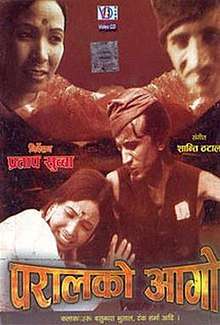Paral Ko Aago
Paral Ko Aago (Nepali: परालको आगो) is a 1978 Nepali black-and-white film directed by Pratap Subba and produced by Cineroma.[1] It is based on a story of the same name by the Nepali writer Guru Prasad Mainali.
| Paral Ko Aago | |
|---|---|
 Movie poster | |
| Directed by | Pratap Subba |
| Produced by | Cineroma |
| Story by | Guru Prasad Mainali |
| Music by | Shanti Thatal |
Release date |
|
Running time | 1h 19m |
| Country | Nepal |
| Language | Nepali |
Plot
A man beats his wife after getting drunk. So the wife runs away. Then the man starts seeks her and finally gets her at last. Then the film ends with the title Paral ko aago.
Cast and crew
- Tanka Sharma
- Basundhara Bhusal
- I.K. Singh
- Menuka Pradhan[1]
Production
The film was shot in areas around Kalimpong and Darjeeling, India in 1976.[2] Released in 1978, the black-and-white movie proved to be a great success due to its story and melodious music.[3]
Soundtrack
| No. | Title | Singer(s) | Length |
|---|---|---|---|
| 1. | "Chaubandi Ko Toonama" | Aruna Lama,Dawa Gyalmo,Shankar Gurung | 3:16 |
| 2. | "Dherai Chubul Nagara Baini" | Dawa Gyalmo, Aruna Lama | 2:17 |
| 3. | "Udi Jau Bhane Mo Panchi Hoina" | Aruna Lama | 4:31 |
| 4. | "Suna Maya" | Aruna Lama, Deepa Gahatraj | 4:29 |
The lyrics of the songs were written Manbahadur Mukhiya and Indra Thapaliya and the songs were sung by Aruna Lama, Dawa Gyalmo, Pema Lama, Shankar Gurung and Deepa Gahatraj.
Dance
Biswa Hingmang was the lead male dancer in the song “Chowbandi ko Tunama”. It was his first appearance in Nepali film. The dance was choreographed by Deodutt Thatal, a renowned dance director of Nepali cinema. In the dance group, the lead female dancers were Shanti Chhetri, Purnima Khargdha, Shanta Gurung and Sobha Chhetri. The dance was shot near Rangeet Khola at Singhla, Darjeeling.
References
- "Nepali Film – Paral Ko Aago (1978)". filmsofnepal.com. 29 August 2009. Retrieved 24 April 2015.
- Limca Book of Records. Bisleri Beverages Ltd. 1999. Retrieved 6 March 2012.
- Rajadhyaksha, Ashish; Willemen, Paul (1999). Encyclopaedia of Indian Cinema. British Film Institute. p. 629. Retrieved 6 March 2012.